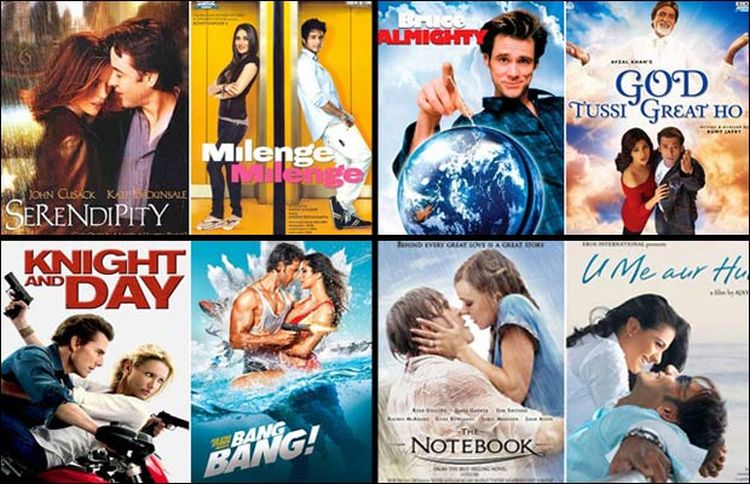When it comes to movie making, none do it better than Hollywood and Bollywood.
But, as you might have noticed, both industry giants have different methods of doing business. Truthfully speaking, while both make movies, they both make very different movies.
That’s not to say that they don’t make movies around a specific genre, but the main distinctions revolve around how both make film. So, to answer the age-old question, we’re going to tell you about the X major differences between Bollywood and Hollywood movies.

Source:businessofcinema.com
1. Different Topics (Genres)
We just said that the issue of genres isn’t really the problem here. But why have we included it then? Well, it’s not like either of them makes a specific genre of movies, but that it focuses a lot on it.
For example, in Bollywood filmmaking, dance sequences are very common. They are so common than up to 80% of all Bollywood films have dance sequences. Not only that, but dance makes around 60% of the average Bollywood film, the rest of it is narrative.
Other factors that Indian film has in abundance are emotions, romance, comedy, action suspense, and many more. Again, that’s not to say that Hollywood doesn’t have it, but the narrative of how they are presented is fundamentally different due to religions and cultural factors.
2. Special Effects
If you thought that Avengers: Endgame had special effects, then you haven’t seen a Bollywood blockbuster. Some are ridiculously funny with the amount of CGI and special effects. Others are moderate, but the main thing to note here is that a Bollywood movie either has an abundance of special effects or none at all.
While CGI is a rear commodity in Bollywood, others are slowly catching up.
3. Less Budget
When it comes to creating a high-quality film, the more budget a studio has generally reflected in a better Box Office performance. While there are obvious examples, such as the Joker which cost only around $55 million and made $1.07 billion, the formula generally tends to work.
The whole of Bollywood spends an average of around $1.5 million on a film, compared to $47 million in Hollywood. But there are areas where Bollywood is superior to Hollywood, and that’s mostly in the annual films produced which India makes around 1013 compared to 730 in the United States.
This does account for a very poor quality-to-quantity ratio, but it is a fundamental difference that both giants have. Furthermore, it goes without saying that a smaller budget does restrict artist freedom and innovation.
4. The Market

Source:mapsofindia.com
Indian cinema can claim a victory here, but also a very big loss. When it comes to exploring the market, no one sells more tickets than Bollywood.
Indian cinematography sells around 3.6 billion tickets every year, compared to the 2.6 in the United States. This is a very real victory that Hollywood has even acknowledged.
However, where exactly does Bollywood lose?
Do you have a guess? Yep, the international market. While Indian films do sell a lot on the international market, it makes nothing compared to the giants of America.
American film sees worldwide revenue of around $56 billion, compared to the $1.4 billion of Indian film. If we take into account that the average American movie spends around $25 million on advertisements, compared to the $500,000 that Indian movie production companies spend, and we can see why that’s the case.
But we’ll include another small victory from the recent skirmish between both giants, and that’s that Bollywood has seen an annual growth rate of around 13% for 2018, compared to the 5.7% of their American rivals.
Make sure to head over to pagalsongs to know more about any potential movies coming out.
5. The Cast
It’s not only the actors that get the love in Hollywood. Everyone from the cameraman down to the singers and even the on-site crew get love and praise when a movie is in the making.
In Indian cinematography, unfortunately, directors and movie producers only want the best of the best to star in their movies. Everything else, the writers, singers, cameramen, etc, are second in importance.
Very few production houses will go with an inexperienced actor to star in their film. It’s not uncommon for production houses to “fight” for a prominent actor to be in their film. These production houses will often time bid for the actor in terms of salary and even his role in the film.
6. The Crew
We cannot stress how big this problem is in Indian cinema. It’s so big that we had to include it once again as the major difference between both powerhouses.
In America, directors and producers have enough time and resources to focus on the project itself. This is why Hollywood makes star movies, compared to their Indian counterpart that makes movie stars.
In America, the project is most important. Everyone working on the project is important. And that means that directors and producers focus A LOT on finding the perfect team.
In India, on the other hand, films are made in such ratios that directors and producers have no time what so ever to screen for the perfect team to work on a film.
Deadline issues, unfinished scripts, and improvisation is very common in Bollywood.
7. Restrictions
When it comes to restrictions in filmmaking, India is best at it. Namely, anyone can make it in Hollywood. Just take a look at Sylvester Stallone or Arnold Schwarzenegger.

Source:animatedtimes.com
One is Italian-American that had a brilliant script for Rocky, and the other is a Mr. Olympia bodybuilder from Austria that became Governor of California through his Hollywood history.
In India, this isn’t a possibility. No one will want to star nor hire cast or crew from foreign countries. Not even the United States.
Directors and producers are very much singleminded and will work with whom they know. And while Quentin Tarantino is well-known for working with the best actors on more than a few occasions, I don’t think that you can compare Tarantino with your average Bollywood film producer.






